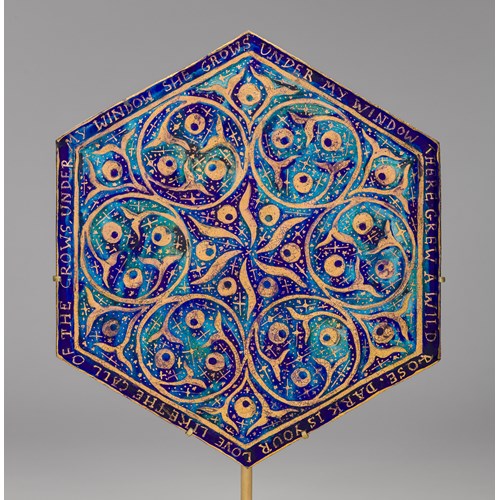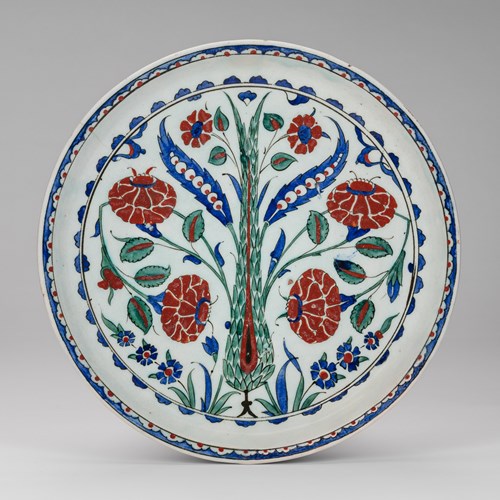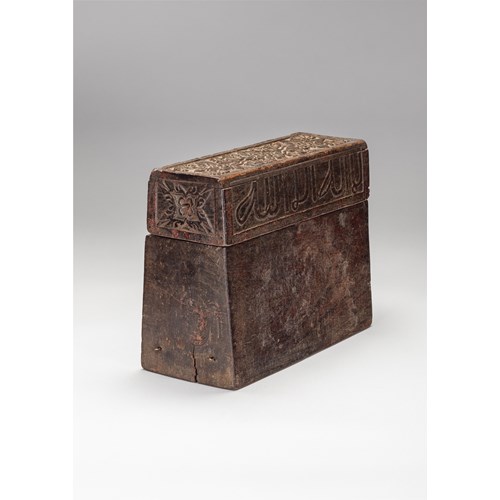Marketplace
A rare early Ottoman Shaffron
A rare early Ottoman Shaffron
Epoque 16th Century
Origine Ottoman Turkey
Medium Steel
Dimension 59 x 22 cm (23¹/₄ x 8⁵/₈ inches)
An impressive shaffron (also known as chanfron and chamfron) or baraki with eye guards, fitted with two cheek pieces and two temple pieces attached with mail links to the central plate on each side. The central piece is formed of a single piece of steel and tapers towards the bottom by the nose. The plate is flanged at the ears and wide, shallow grooves on the plate follow the contours of the eyes and ears, and continues to the muzzle. At the top of the plate is a raised crest holder or plume socket, and beneath it appears the engraved Ottoman arsenal mark (tanğa) of St. Irene. The plate features split palmette decoration and engraved scrollwork.
This shaffron was designed for an Ottoman heavy cavalryman. This would have covered the forehead of the horse. It was an essential piece of armour in battle. Some shaffrons made of tombak (gilt copper) while others were made of steel. Those made of tombak were much lighter than steel ones and were used more often for parades and ceremonies. A shaffron like this one would have been used primarily for military purposes in battle, as it would provide more protection. It would have once been a part of full horse armour of mail and plate, and the rider would have been similarly protected.
Comparative Material:
The Arts of the Muslim Knight : The Furusiyya Art Foundation Collection. Milano: New York: Skira, 2008. Many examples of chamfron, specifically see p. 342.
Hales, Robert. Islamic and Oriental Arms and Armour: A Lifetime’s Passion. 2013. pp. 330-331
Worcester Museum Object no. 2014.28
Metropolitan Museum: Accession no. 36.25.496, no. 21.102.4
Stock no.: A5464
This shaffron was designed for an Ottoman heavy cavalryman. This would have covered the forehead of the horse. It was an essential piece of armour in battle. Some shaffrons made of tombak (gilt copper) while others were made of steel. Those made of tombak were much lighter than steel ones and were used more often for parades and ceremonies. A shaffron like this one would have been used primarily for military purposes in battle, as it would provide more protection. It would have once been a part of full horse armour of mail and plate, and the rider would have been similarly protected.
Comparative Material:
The Arts of the Muslim Knight : The Furusiyya Art Foundation Collection. Milano: New York: Skira, 2008. Many examples of chamfron, specifically see p. 342.
Hales, Robert. Islamic and Oriental Arms and Armour: A Lifetime’s Passion. 2013. pp. 330-331
Worcester Museum Object no. 2014.28
Metropolitan Museum: Accession no. 36.25.496, no. 21.102.4
Stock no.: A5464
Epoque: 16th Century
Origine: Ottoman Turkey
Medium: Steel
Dimension: 59 x 22 cm (23¹/₄ x 8⁵/₈ inches)
Plus d'œuvres d'art de la Galerie






_T638839371761583625.jpg?width=500&height=500&mode=pad&scale=both&qlt=90&format=jpg)


_T638760967878733852.jpg?width=500&height=500&mode=pad&scale=both&qlt=90&format=jpg)